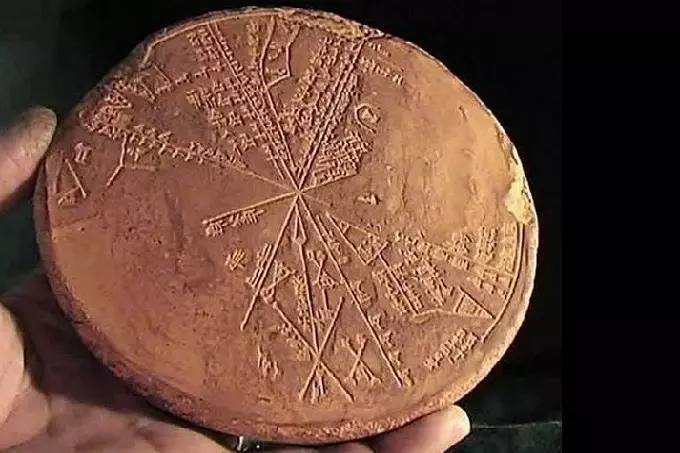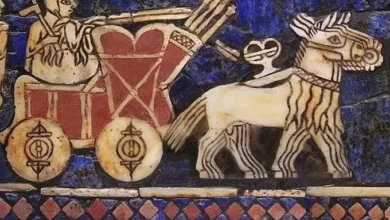Why ancient Sumerian map still causes controversy?

Is it possible that the ancient Sumerians observed and recorded the fall of the asteroid Aten more than 5000 years ago? Atens – asteroids that cross the earth’s orbit
For over 150 years, scientists have been trying to unravel the mystery of a controversial cuneiform clay tablet that points to the so-called Köfels Impact Event observed in antiquity.
The Ashurbanipal Library was the first of its kind in history. In it, the King collected many clay tablets containing various sources of knowledge. Many such ancient records are housed in London and various other museums around the world.
The round stone tablet was recovered from the underground library of King Ashurbanipal in Nineveh (Iraq) at the end of the 19th century. Long thought to be an Assyrian tablet, computer analysis compared it to the sky over Mesopotamia in 3300 BC. and proves that he has a much older Sumerian origin than previously thought.
The Sumerian star map showed observations of the Koefels impact over 5500 years ago. The tablet is an “astrolabe” – the earliest known astronomical instrument. It consists of a segmented, disc-shaped star map with marked angle units inscribed on the rim.
Unfortunately, a significant part of the planisphere is missing from this tablet (about 40%), the damage to which refers to the sack of Nineveh. There is no inscription on the reverse side of the plate.
A cuneiform tablet in the collection of the British Museum known as the “Planisphere” is still being studied by modern scholars. It provides exceptional evidence for the existence of complex Sumerian astronomy.
In 2008, 2 authors, Alan Bond and Mark Hempsell, published a book about the disc-shaped tablet called Sumerian Observation of the Köfels Impact Event.
Raising a storm in archaeological circles, they have translated the cuneiform text and claim that the tablet contains records of an ancient asteroid impact, the Köfels impact, which occurred in Austria around 3100 BC.
The giant landslide, centered on Köfels in Austria, is 500m thick and 5km in diameter and has long been a mystery since geologists first looked at it in the 19th century.
The conclusion reached by studies in the mid-twentieth century was that it must be due to a very strong meteor impact due to evidence of crushing pressures and explosions.
But this point of view has lost its meaning, as a much better understanding of the places of influence was achieved at the end of the 20th century.
In the case of Köfels, there is no crater, so clearly, now it does not look like an impact site. However, the evidence that puzzled earlier researchers remains unexplained by the fact that this is just another landslide.
So what is the connection between the complex Sumerian star map found in the underground library at Nineveh and the mysterious impact that took place in Austria?
Examination of the clay tablet reveals that it is an astronomical work, as it has drawings of the constellations, and the text has known constellation names. It has attracted a lot of attention, but in over 100 years, no one has provided a convincing explanation for what it is.
With the help of modern computer programs that can model trajectories and reconstruct the night sky thousands of years ago, researchers have determined what the Sumerian Planisphere tablet refers to. This is a copy of the night diary of a Sumerian astronomer, in which he records the events in the sky before dawn on June 29, 3123 BC. (Julian calendar).
Half of the tablet records planetary positions and cloud cover like any other night, but the other half of the tablet describes an object large enough for its shape to be seen, even though it is still in space.

Astronomers have made an accurate record of their trajectory relative to the stars, which, with an error of more than one degree, is consistent with the impact on Köfels.
Observations show that the asteroid has a diameter of more than a kilometer, and the original orbit around the Sun was of the Aten type, a class of asteroids that orbit close to the earth, which is resonant with the earth’s orbit.
This trajectory explains why there is no crater in Köfels. The angle of incidence was very low (6 degrees), meaning that the asteroid undercut a mountain called Gamskogel above the town of Längenfeld, 11 km from Köfels, which caused the asteroid to explode before it reached its final impact point. Going down the valley, it turned into a fireball with a diameter of about 5 km (the size of a landslide).
When the meteorite hit Köfels, it created tremendous pressure that pulverized the rock and caused a landslide, but since it was no longer a solid object, it did not create the classic impact crater.
Mark Hempsell, discussing the Köfels event, said: “One more conclusion can be drawn from the trajectory. The trailing plume from the explosion (mushroom cloud) will be bent over the Mediterranean Sea, returning to the atmosphere over the Levant, Sinai, and Northern Egypt. The heating of the earth, although very short, will be sufficient to ignite any combustible material, including human hair and clothing. Probably more people died under the plume than in the Alps because of the explosion.”
In other words, a unique ancient star map shows that the Sumerians observed the asteroid Aten, more than a kilometer in diameter, which collided with Köfels in Austria in the early morning of June 29, 3123 BC.




